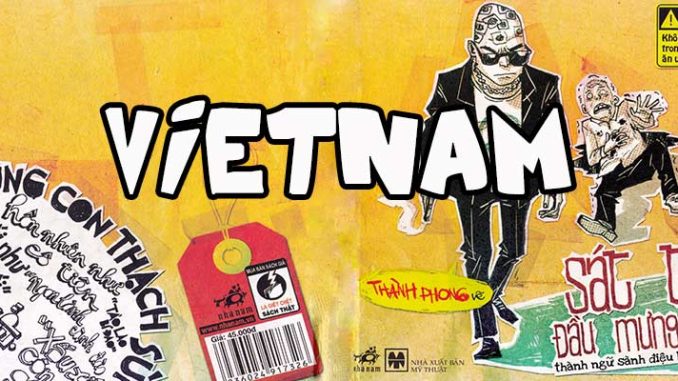
The Concepts of Comic in Vietnam
Comics in Vietnam have suffered criticism from the general public because of the widely felt overtones surrounding the word “comic”. “Comic” in Vietnamese is “truyen tranh” — whereby “truyen” means “story” and “tranh” means “picture” and together these are perceived by the older generation as stories with pictures for children. But shifting forward to the younger generation in Vietnam, the word “comic” is largely identified with one thing; Japanese manga.Traditionally, As “pictorial stories”, comics have not been highly regarded by society due to the long-standing influence of Chinese Confucianism, where a “story (truyen)” needs to have educational and moral values set in its content. Until the 1990s, comics in Vietnam retained the same kind of storylines with wisdom and ideals at their nucleus. This was to change with Manga with its different genres targeting many age groups. But for Vietnam’s older generation, when seeing sex scenes, violence, colorful language and mature subject matter, they would consider these harmful to their children.
Despite the fact that Manga has become very popular and is an integral part of Vietnamese youth culture, it is not considered as literature or “the quintessence (tinh hoa)” of a country. 1
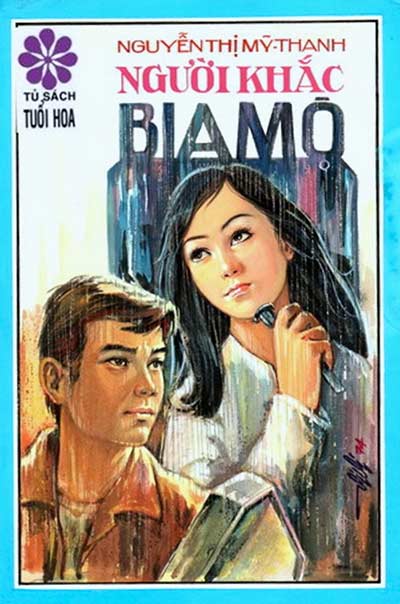
Vietnamese Comics
In the early days of Vietnamese comics, they were common in newspapers and published in the form of albums. Vietnamese comics had various themes and were used for entertainment, education and propaganda. From the late 1960s until 1975, comics flourished in Saigon. 2 These led to an increase in the number of comic artists. The most famous illustrator and comic artist at the time was Vo Hung Kiet 3 and he was also an illustrator for stamps. His comics were much loved by children (Figure 2 and 3). During 1970s, besides Vietnamese comics, there were Chinese Lianhuanhua (a palm-size picture book of sequential drawings), Bande Dessinée (Franco-Belgian comics), and American comics. However, these comics were only poorly printed pirated copies that were translated into Vietnamese.
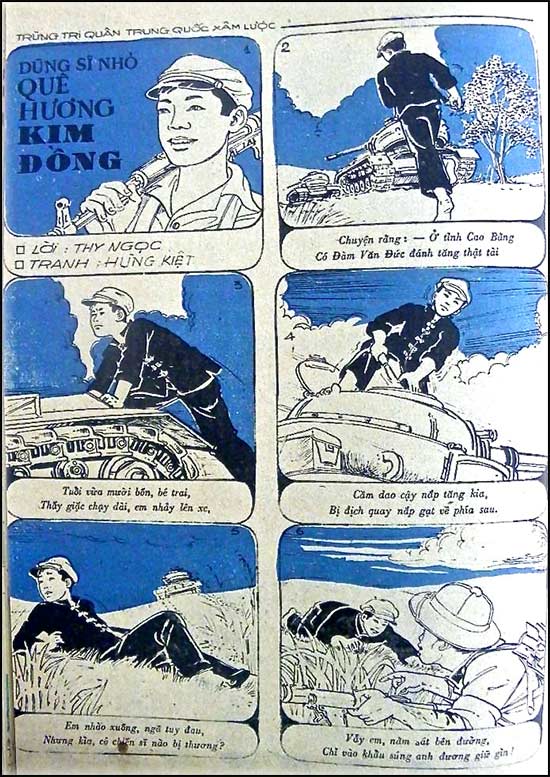
Translation of Figure 3. (Based on ordinal numbers in picture)
1— Kim Dong – The little hero of our country Plot: Thy Ngoc Picture: Hung Kiet
2— In Cao Bang province, there is a boy named Dam Van Duc who is good at fighting against tanks.
3— He is 14 years old. When he sees the enemy run away, he jumps onto the tank.
4— While using his knife to pry open the hatch of the tank, the enemy made the tank move and he fell down
5— He was hurt but after he fell down, he saw a wounded soldier.
6— The wounded soldier pointed to his gun and told him to lay down on the grass.
Vietnamese comics have changed much since 1987 as they steadily developed though the years and gradually became similar to American comics with a growing number of comic artists and comic genres. Meanwhile, in response to the needs of children, the government attached special importance in encouraging the creation of comics. The most famous artist was Hung Lan whose comics were popularly read (Vietnamese fairy tales, Toet and Xe, Co Tien Xanh, etc.). The content of these publications was broadly educational and offered lessons in moral philosophy for the reader.
Everything was to change in 1992 with the import of Doraemon by Kim Dong Publishing House, it became the first Manga in Vietnam. Doraemon quickly became a phenomenon with over 40,000 copies sold. After its success other publishers began to publish Manga. But it was later in 1995 when the Manga storm would really hit with the publication of Sailor Moon and Dragon Ball. Suddenly Vietnamese comics with educational and moral stories were overwhelmed and dull by comparison. Manga was able to engage with a broad readership and was readily available; it saturated the market even though most was then illegally printed. That changed in 2004 when Vietnam finally signed an expanded version of the Berne Convention for the Protection of Literary and Artistic Works, and copyright was discussed and respected. The management of sales and content of manga has since become strictly controlled.
A New Form of Vietnamese Comics
Despite the popularity of Japanese Manga and also comics from Korea and China fighting for a place in the Vietnamese market, 4 the rise of comics in a Vietnamese style was slow to gain pace given lingering prejudices, the feeling that comics were for children. Yet gradually, Vietnamese artists started to produce comics. In 2002, the Phan Thi Company published the comic series titled Than dong Dat Viet (Vietnamese Child Prodigies) and this was a turning point in Vietnamese comics (Figure 4 and 5). Than dong Dat Viet is about the adventures of Le Ty (Prodigy Ty) and his friends who fight against things perceived as bad. The work is based on Vietnamese customs and national heroes. Along with the drama, the comic also features historical facts and reintroduces Vietnamese national heroes somewhat vividly with exaggerated facial expressions and interesting dialogue. It attracted many young readers and became a long-selling comic with more than 120 volumes produced. The comic might be considered similar to Manga in panel layout and onomatopoeia (the formation of a word from a sound associated with what is named, and the style in which characters are drawn.
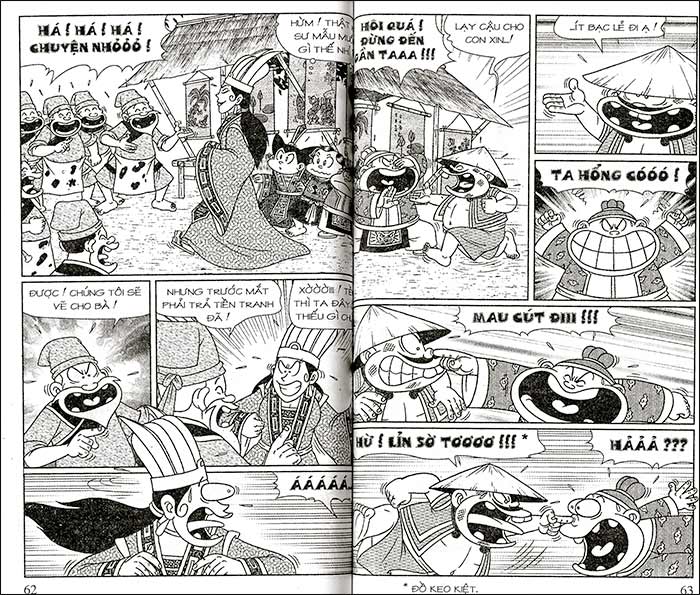
Translation of Figure 4. (From left to right)
1— Ha ha ha… No problem!
2— Uhm, what exactly does madam want?
3— SO STINKY! Keep away from me!!!
4— Gentlemen, please give me…
5— …a little money!
6— I HAVE NO MONEY!
7— Okay! We will draw for you.
8— But you will have to pay us the money first.
9— MONEY? No problem!
10— Aaah…
11— Get out of here quickly!
12— You are so selfish!
13— What??

Translation of Figure 5. (From left to right)
1— Hm! I got you!
2— Ahh!! 3: You’re coming with me to see the judge!
4— Are you guys okay?
5— Eldest sister, it hurts so much!
6— That’s nothing, why is he crying so much?
7— He is really a crybaby!
8— What?
Since 2011, the number of comics penned by Vietnamese artists have been increasing dramatically. Amongst them, Dat Rong (Dragon Land) in a Manga style by Dimensional Art Group 5 was honored with a Bronze Award at the 6th International Manga Award. 6 Its plot is inspired by the Vietnamese legend of Son Tinh – Thuy Tinh. 7 Aside from this, “Danh Tac Viet Nam (Masterpiece Comics)” published Chi Pheo, Giong to (The Rainstorm), and Tat den (Lights Out!), comics adapted from famous masterpieces of Vietnamese literature by BRO, and additionally, the Three-2D Artist Group, 8 also found attention on the comic market. In recent years, Nguyen Thanh Phong has become a well-known independent comic artist in his own right.
Since 2004, Phong’s comics have been serialized in various magazines. “Long than tuong (The Legend of Long Than Tuong)” serialized in Tre Publishing House’s Truyen tranh tre (The Young Comics) magazine, “Nhi and Tun” was serialized in Phan Thi Company’s Than dong Dat Viet Fanclub magazine. Phong became much more widely known and popular in Vietnam for his picture book titled Sat thu dau mung mu (The Killer With a Head Full of Festering Sores) (Figure 6).
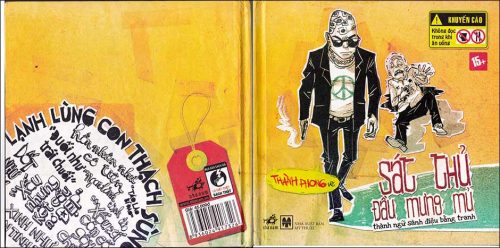
Published in August 2011 by a joint venture between the Nha Nam Company and the Fine Arts Publishing House, this picture book had an initial run of 5,000 copies. 9 It included around 120 separate drawings, each accompanied by a short caption borrowed from common informal Vietnamese idioms. For example, the traditional Vietnamese saying “when a horse is sick, the whole stable refuses grass”, which means “love people like loving oneself”, was revised to “when a horse is sick, the whole stable can eat more grass” which implies a degree of selfishness and uncaring for others (Figure 7). Additionally, there is also a series of drawings in this book illustrating a set of humorous rhyming similes drawing on contemporary teen slang which compares different emotions to various animals yet without implying anything tangible. For example “chan nhu con gian” (as bored as a cockroach), “buc nhu con muc” (“as frustrated as a squid”), “ngoc nhu con oc” (“as stupid as a snail”).
According to supporters, this picture book is interesting as it includes re-created Vietnamese proverbs and new slang that cannot be found in Vietnamese dictionaries and this is displayed alongside funny or comical pictures 10. Critics point out that the re-created idioms might be a bad influence, especially in the way young people use the Vietnamese language and in their thoughts. 11 Since so much contrary criticism has arisen in regards to this book, the Director of the Vietnamese Publishing Department challenged the Fine Arts Publishing House to explain their decision in publishing it. In turn, the Publishing House requested the Nha Nam Company not only to stop the publication of the book, but also to withdraw all printed versions from the market citing that sections of the contract signed with the Fine Arts Publishing House had been ignored. 12 In particular, the Publishing House had allowed the Company to publish the book with the title “Re-created Idioms”, but instead published it with the title “Sat thu dau mung mu”.

Translation of Figure 7.
1— When a horse is sick, the rest of the stable can eat more grass.
2— Hooray!
3— Who cares?

In Vietnam, If a book causes controversy, the publication will be withdrawn and it will be ignored by the mass media. However, Sat thu dau mung mu has become an uncommon phenomenon. After publication was halted, a talk show called “The language of Youths in the Internet age” examined the case of Nguyen Thanh Phong’s Sat thu dau mung mu at an event in March 2012 which took place at L’Espace (the French Culture Center in Hanoi). This talk show looked at the pros and cons of this book. Although some young Vietnamese were among the publication’s critics, a vocal segment of young supporters argued in its favor and found that some adults agreed with them, especially academics such as, Professor Van Nhu Cuong 13 who remarked that new ways of playing around with Vietnamese words and re-creating idoms were innovative since the official Vietnamese language could not reflect such expressions well enough, thus, it created new value from the old. 14 Furthermore, Professor Pham Van Tinh 15 commented that this picture book had helped enrich the Vietnamese language and made the point that the tendency for renewing language needs to be accepted. 16 These statements helped to promote a revaluation the book. Subsequently, the Nha Nam Company changed the title of the book to “Phe nhu con te te (Pangolin in a Spin)” when it was republished (Figure 8).
Several days after the book was rereleased, illegal scans of the work could be found on the Internet. Frustrated by this unfortunate turn of events, Phong wrote a note titled “To the Thief” on his personal blog which was addressed to those who had copied the work. 17 The existence of illegal scans such as this has brought about a decrease in the purchase of printed comics. Given this, Vietnamese comic artists will struggle to survive or make money from comic creation as the copying hampers the further development of industry as a whole. A new title on the shelf would need to compete with scanned copies of old titles online, this could be why the new Phe nhu con te te is not selling as well as the old one.
Phong and his friend, Khanh Duong, founded the Phong Duong Comic Artists Group, in which Phong is responsible for drawings and Duongtakes for the plots. Phong’s profile saw a boost after his work, Orange (written by Khanh Duong), was published in 2011 by the Phan Thi Company. Orange has become his first comic series that was published as a comic book.
The plot is about Lam, Secretary of class 11A3 in Crow High School, who is looking for a basketball genius with an orange basketball armband. Like Than dong Dat Viet, this comic also could not escape the influence of Manga. It shares similarities with Slam Dunk, a similarity that Phong has admitted. 18 The panel layout and use of onomatopoeia were directly influenced by Manga (Figures 10, 11 and 12). Despite being influenced by Manga, Phong’s drawings of characters are the same as American comics. Aside from drawing more realistically, the plot takes inspiration from the daily lives of Vietnamese youths. The comic reconstructs not only streets and buildings, but cultural images such as markets or ancestor altars (Figures 13 and 14). The narrative of the story is based on Vietnamese culture and the realistic drawing style has made Orange a unique and distinguished phenomenon. Phong Duong has been able to establish a characteristic style for Vietnamese comics, and, especially given his body of work, is considered to be one of Vietnam’s most promising young comic artists.

Translation of Figure 10. (From left to right)
1— Trang! I forgot my Linkin Park World Tour CD in your bag, please bring it with you tomorrow when you go to school!
2— What? Linkin Park? In Trang’s bag???
3— That’s it!
4— Good dog, don’t bite me, please!
5— How dare you to call me a dog???
6— Grrr! Ahhh!
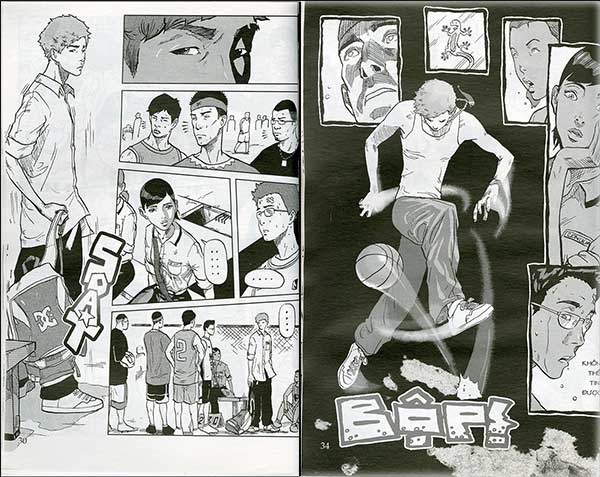
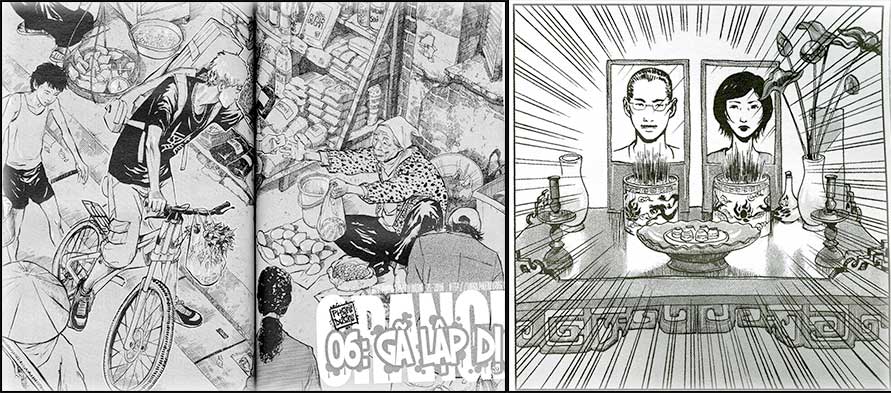
Orange by Phong Duong, 2011, Vol.1, pp. 88-89 &
FIGURE 14. Vietnamese ancestor altar —
Orange by Phong Duong, 2011, Vol.1, p. 119
In November of 2013, Phong released his newest short comic titled “Hang xom (The Neighbor)”, intending for the work to join the exhibition “Pieces of life”, with portraits, self-portraits, and cartoon works featuring the daily lives of people in Hanoi which was held at L’Espace. However, the exhibition of this comic was not allowed as its content was thought to be unsuitable to represent Vietnamese culture because of its sex scenes (Figure 15). 19 The story of “The Neighbor” 20 is about the quarrels between a young married couple and an old widow who lives in a the neighborhood. The reason that the widow has quarrelled with the couple is because of the water that drips from the couple’s roof onto her house.

Translation of Figure 16. (From left to right)
1— (Sound effects of the bed, “Squeak, Creak!”) Ah! Uh!
2— Ah! Uh!
3— (Squeak!) This bed is just so freaking loud!
4— Hey, what if the neighbors can hear us?
5— Just… let them be jealous.
Uh!
6— Ah!
Don’t worry! The old widow downstairs is hard of hearing…
Aha! When we moved in here, we made a lot of noise but she didn’t complain at all.
7— Well that aside, you still shouldn’t fix anything at night. I can’t stand the noise.
8— Stop talking or this won’t feel good anymore. Let’s go!
9— Ah!
Hey, don’t pull on the curtain! You’ll tear it.
Noting the resurgence of comics, the Vietnamese Government has used them to propagate government policies. In September 2013, the Phan Thi Company released a series of Than dong Dat Viet in which the stories focused on Vietnam’s declared authority to protect sea borders and islands against claims from the government of China. 21 Hence, there has been a real contrast in the Vietnamese authority’s attitude toward comics. In this dubious situation, Vietnamese comics are not afforded the leeway to stabilize and find their own equilibrium in contemporary Vietnamese culture.
Nguyen Hong Phuc
Nguyen Hong Phuc is a master’s student of Graduate School of Manga Studies, Kyoto Seika University.
Kyoto Review of Southeast Asia. Issue 16 (September 2014) Comics in Southeast Asia: Social and Political Interpretations
Bibliography
Berndt, Jaqueline edited. Comics Worlds and the World of Comics-Towards Scholarship on a Global Scale (Global Manga Studies, vol.1), Kyoto Seika University International Manga Research Center, 2010.
Do, Huu Chi “Comic art in Vietnam: A Brief History,” International Journal of Comic Art 13.1 (Spring 2011): 62-86.
Do, Mimi H. The Search for Modernity: Literature and Vietnamese Nationalism, 1900-1939 (M.A. Thesis), University of Hawaii, 2002.
Furuta, Motoo. Betonamu no Sekaishi – Chuuka Seikai kara Tounan Ajia Sekai e (Vietnam in the world history Toward to the world of Southeast Asia from the world of China), (Tokyo Daigaku Shuppankai, 1995).
Groensteen,Thierry. The System of Comics, (University Press of Mississippi, 2009).
Ichiki, Jun – Ogi, Fusami – Motohama, Hidehiko jointly edited. Manga wa ekkyou suru! (Beyond Borders: the Transnational Power of Manga), (Sekaishisousha, 2010).
Iwashita, Houyuu. “Manga no Zuzou ni okeru “Kigosei” nitsuite”, Manga Kenkyuu Vol.12 (Manga Studies Vol.12), (Nihon Manga Gakkai, 2007), 54-61.
Marr, David G. Vietnamese Tradition on Trial, 1920-1945, (University of California Press, 1984).
McHale, Shawn Frederick. Print and Power: Confucianism, Communism, and Buddhism in the Making of Modern Vietnam (Southeast Asia: Politics, Meaning, and Memory), (Honolulu: University of Hawaii Press, 2004).
Natsume, Fusanosuke. Manga wa naze omoshiroi no ka – Sono hyougen to bunpou (Why are manga interesting? – Its expression and grammar), Tokyo: Nihon Housou Shuppan Kyoukai, 1997.
Ono, Kouse. “Zoushoku suru Manga – MANGA wa Sekai ni hirogatteiru” (Growing Manga – MANGA is spreading throughout the world), Manga wa ekkyou suru! (Beyond Borders: the Transnational Power of Manga), (Sekaishisousha, 2010), pp. 40-64.
Sekiguchi, Sueo – Tran, Van Tho jointly edited. Gendai Betonamu Keizai – Sasshin (Doi Moi) to Keizai Kensetsu (The contemporary Vietnamese economy – Renovation (Doi Moi) and Economic construction), (Keisoshobo, 1992).
Tran, Huy Lieu. Mot bau tam su (A gourdful of confidences), (Cuong Hoc Thu Xa Press, 1927).
Yoshikawa, Norihiro. “Chugoku ni okeru Kaizokuban Nihon Manga nitsuite no Kousatsu” (The consideration of pirated Japanese manga in China), Manga Kenkyuu Vol.2 (Manga Studies Vol.2), (Nihon Manga Gakkai, 2002), pp. 131-136.
Websites (Last accessed: February 10, 2014)
“Comic popularises VN sovereignty”, Viet Nam News <http://vietnamnews.vn/life-style/245480/comic-popularises-vn-sovereignty.html>.
Ha Trang, “Theneighbor was not allowed to be exhibited, the Director of Fine Art Department explained the reasons (Truyen tranh Hang xom bi cam, Cuc truong ly giai nguyen nhan),Infonet of Ministry of Information and Communication of Vietnam <http://infonet.vn/truyen-tranh-hang-xom-bi-cam-cuc-truong-ly-giai-nguyen-nhan-post104877.info>.
Hoang Anh, “The Killer With a Head Full of Festering Sores: The old people support, the young people object” (Sat thu dau mung mu: Nguoi gia me, nguoi tre che), VN Express <http://giaitri.vnexpress.net/tin-tuc/gioi-sao/trong-nuoc/sat-thu-dau-mung-mu-nguoi-gia-me-nguoi-tre-che-1918247.html>.
Minh Nhat, “Re-created Idioms: the more being withdrawn, the more spreading” (Thanh ngu sanh dieu: Thu hoi, cang lan nhanh), Nhan Dan Online <http://www.nhandan.org.vn/mobile/_mobile_vanhoa/_mobile_diendan/item/18830002.html>.
Phong’s interview, “Thanh Phong – I can’t live without drawing” (Thanh Phong – “Neu khong ve truyen tranh, toi se chet”), Japan Foundation Online <http://jpf.org.vn/2012/05/10/thanh-phong-neu-khong-ve-truyen-tranh-toi-se-chet>.
Shine Toshihiko, “Current State of Creating Comics in Vietnam and the Role of Japan”(Thuc trang sang tac “truyen tranh co cot truyen” o Viet Nam va vai tro cua Nhat Ban), Vietnamese History Forum <http://www.lichsuvn.info/forum/showthread.php?t=9232&page=3>.
Thanh Huong, “Nguyen Thanh Phong: Eat – Sleep – Draw and Imagine” (Nguyen Thanh Phong: An – Ngu – Ve va tuong tuong), VTC News{こうどじょうほうつうしん}{すいみん} <http://vtc.vn/chan-dung-doi-thoai/nguyen-thanh-phong-an-ngu-ve-va-tuong-tuong-359807.html>.
Thanh Phong, “To the Thief (Gui ban an cap) <http://phong210.wordpress.com/2011/10/21/g%E1%BB%ADi-b%E1%BA%A1n-an-c%E1%BA%AFp>.
The withdrawal of “The Killer With a Head Full of Festering Sores”: Resolved in accordance with the social criticism? (Thu hoi Sat Thu dau mung mu: Xu ly theo “du luan”?), Tuoi Tre Onlin <http://tuoitre.vn/Tet-2014/Tet-moi-mien/462350/Thu-hoi-Sat-thu-dau-mung-mu%C2%A0-Xu-ly-theo-%E2%80%9Cdu-luan%E2%80%9D.html>.
Thoai Ha, “The picture book about “Re-created Idioms” has caused the pros and cons” (Tranh ve “ngon ngu cai bien” cua gioi tre gay tranh cai), VN Express <http://giaitri.vnexpress.net/tin-tuc/gioi-sao/trong-nuoc/tranh-ve-ngon-ngu-cai-bien-cua-gioi-tre-gay-tranh-cai-1915509.html>.
Vietnamese Online Dictionary <http://tratu.soha.vn/dict/vn_vn/Truy%E1%BB%87n_tranh>.
Vietnamese Wikipedia <http://vi.wikipedia.org/wiki/Truy%E1%BB%87n_tranh>.
The list of Phong’s works:
“Truyen thuyet Long Than Tuong (The Legend of Long Than Tuong) ”, Truyen tranh tre, (Tre Publishing House, 2004).
“Nhi va Tun (Nhi and Tun)”, Than Dong Dat Viet Fanclub, (Phan Thi Company, 2004).
“Cau be va may bay giay (The Boy and the Paper Plane)”, Liquid City Volume 1, (Image Comics, 2008), p. 7.
Bon anh tai – Sang tau doi no (Four Incredible Guys – A Journey to China to Recover a Debt), (Nha Nam Company, 2009).
“Be lon, lon bo (Pig when small – Cow when big)”, 2010, p. 12.
“Bicof Story,” in Liew, Sonny, and Lim Cheng Tju, eds, Liquid City 2, (Image Comics, 2010), p.7.
Orange, Phan Thi Company, 2011.
“Nguoi hoa ho (Man-Turned-Tiger)”, 2011, p.9.
Sat thu dau mung mu (The killer with a head full of suppurating sores), (Nha Nam Company and the Fine Arts Publishing House), 2013.
“Hang xom (The neighbor)”, 2013, p.21.
Notes:
- Tran, Huy Lieu(1927, p.26). ↩
- Do, Huu Chi (2011, p.73). ↩
- Vo Hung Kiet was born in 1945 in Vinh Long, Vietnam and graduated from Saigon Fine Arts University in 1968. He selected VV (“vee-vee” in English or “vi-vi” in Vietnamese) as his pen name. He was an art designer and drew for Magazines such as Tuoi Hoa, Tuoi Xanh, ect. ↩
- <http://www.lichsuvn.info/forum/showthread.php?t=9232&page=3>(accessed February 10, 2014). ↩
- The group includes members like Dinh viet Phuong, Do Nhu Trang, Le Lam Vien and so on. ↩
- An award established to honor Manga artists who contributed to the promotion of Manga overseas by the Minister for Foreign Affairs of Japan. ↩
- Son Tinh – Thuy Tinh is one of the famous Vietnamese myths. Son Tinh is the God of the Mountain and Thuy Tinh is the God of the Water. Son Tinh won in a contest to win a princess’ heart. The loser, Thuy Tinh got very angry and the battle between the two Gods continued from day to day. Finally, Thuy Tinh withdrew his water. However, he had never given up the idea of taking revenge. Thus every year, people have to suffer floods as a consequence of Thuy Tinh’s eternal bitterness and vengefulness. ↩
- This group was founded in 2005, including three members: Hoang Anh Tuan, Pham Kieu Oanh and Nguyen Nhat Nguyen ↩
- http://www.nhandan.org.vn/mobile/_mobile_vanhoa/_mobile_diendan/item/18830002.html> (accessed February 10, 2014). ↩
- <http://giaitri.vnexpress.net/tin-tuc/gioi-sao/trong-nuoc/tranh-ve-ngon-ngu-cai-bien-cua-gioi-tre-gay-tranh-cai-1915509.htm> (accessed February 10, 2014). ↩
- Ibid. ↩
- <http://tuoitre.vn/van-hoa-giai-tri/462107/thu-hoi quyen-sat-thu-dau-mung-mu.html> (accessed February 10, 2014). ↩
- Professor Van Nhu Cuong (born in 1937) is a Doctor of Mathematics, a member of Vietnam National Education Commission and a professor who edited textbook for high schools and geometry textbook for universities ↩
- <http://giaitri.vnexpress.net/tin-tuc/gioi-sao/trong-nuoc/sat-thu-dau-mung-mu-nguoi-gia-me-nguoi-tre-che-1918247.htm>(accessed February 10, 2014) ↩
- Professor Pham Van Tinh is a linguist and currently the deputy editor-in-chief of Lexicography and Encyclopaedia magazine and a member of the Standing Committee of the Viet Nam Linguistics Association. ↩
- Ibid. ↩
- <http://phong210.wordpress.com/2011/10/21/gui-ban-an-cap>(accessed February 10, 2014). ↩
- <http://jpf.org.vn/2012/05/10/thanh-phong-neu-khong-ve-truyen-tranh-toi-se-chet>(accessed February 10, 2014). ↩
- <http://infonet.vn/truyen-tranh-hang-xom-bi-cam-cuc-truong-ly-giai-nguyen-nhan-post104877.info>(accessed February 10, 2014). ↩
- Vietnamese version <http://phong210.wordpress.com/2013/11/14/hang-xom-a-comic-by-thanh-phong>. ↩
- <http://vietnamnews.vn/life-style/245480/comic-popularises-vn-sovereignty.html> (accessed February 10, 2014). ↩
